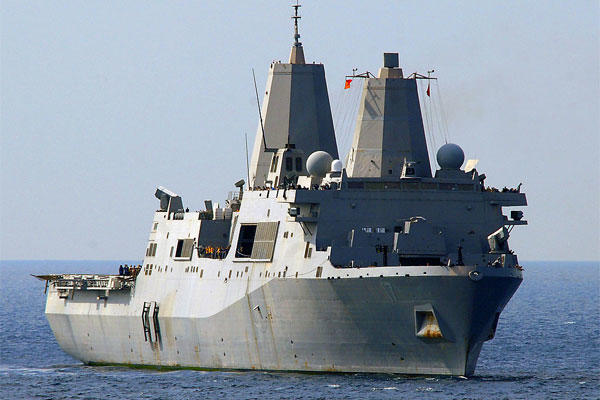The amphibious transport dock San Antonio has moved into the Mediterranean to replace the amphibious assault ship Wasp in conducting airstrikes on Islamic State targets in Libya.
U.S. Africa Command announced Friday that the San Antonio would conduct a relief in place with the Wasp to allow the mission to continue.
An AfriCom spokesman, Charles Prichard, told Military.com the San Antonio would contribute UH-1Y Huey Venoms and AH-1W SuperCobras from the 22nd Marine Expeditionary Unit's aviation combat unit, Marine Medium Tiltrotor Squadron 264 (reinforced). Notably, the San Antonio is not equipped with AV-8B Harriers, which had been the primary strike asset for the Wasp.
"USS San Antonio is more than capable of sustaining the current mission," Prichard said. "The sailors and Marines of the Wasp [Amphibious Ready Group]/22nd MEU team will receive follow-on tasking and continue their deployment to the 5th and 6th Fleet area of operation."
Both the San Antonio and the Wasp are part of the 22nd MEU, which deployed from Camp Lejeune, North Carolina, in June. The Wasp has been in the Mediterranean since Aug. 1, when the U.S. began airstrikes over Libya at the request of the country's government of national accord in efforts to retake the key city of Sirte from ISIS militants.
The ship initially contributed AV-8B Harriers as strike aircraft, then added AH-1W SuperCobra attack helicopters to provide close air support on these strike missions.
So far, U.S. assets have conducted 330 strikes since the mission, Operation Odyssey Lightning, began, AfriCom officials said. That's an average of more than four strikes per day.
The San Antonio is a smaller class of ship than the Wasp, designed to carry roughly half as many personnel and a smaller complement of rotorcraft on its flight deck.
In a release, AfriCom officials said they plan to continue to provide precision airstrikes in support of Libyan forces as they fight to take back compounds and structures used by the Islamic State to launch attacks on friendly forces.
"The airstrikes have significantly reduced Daesh's ability to utilize heavy weapons and enemy fighting positions, as well as having reduced the number of vehicle-born improvised explosive devices intended for attacks on [government of national accord]-aligned forces," the command said in the release, using another term for the Islamic State of Iraq and Syria.
This has already been an eventful deployment for the San Antonio. The ship was among those targeted by missiles launched from off the coast of Yemen as it transited through the strait of Bab-el-Mandeb on its way around the Arabian peninsula and up to the Mediterranean, according to a public Facebook post by Navy Capt. Darren Nelson, commanding officer of the San Antonio.
The ship emerged unharmed, and Nelson praised the crew for "performing flawlessly in defense of the ship."
The 22nd MEU is likely to remain deployed in the Middle East and Pacific areas of operations until early next year.
-- Hope Hodge Seck can be reached at hope.seck@military.com. Follow her on Twitter at@HopeSeck.
Related Video:
Rise of the US Navy | Two Minute Brief





























